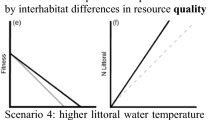Abstract
To explore how climate may affect the structure of natural communities, we quantified the role of thermal stress in setting the high intertidal borders of the acorn barnacle, Semibalanus balanoides. At sites north and south of Cape Cod, a major faunal and thermal boundary on the east coast of North America, we examined the interacting effects of thermal stress and recruit density on individual survivorship. At hotter southern sites, particularly in bays, high intertidal barnacle survivorship was enhanced by experimental shading or by neighbors which ameliorate heat and desiccation stresses. In contrast, at cooler northern bay and coastal sites, neither shading nor group benefits increased barnacle survival, and mortality patterns were driven primarily by predators with largely boreal distributions. Our field results, like recent laboratory microcosm studies, suggest that predicting even simple community responses to climate change may be more complex than is currently appreciated.
Similar content being viewed by others
Author information
Authors and Affiliations
Additional information
Received: 26 January 1999 / Accepted: 5 April 1999
Rights and permissions
About this article
Cite this article
Bertness, M., Leonard, G., Levine, J. et al. Climate-driven interactions among rocky intertidal organisms caught between a rock and a hot place. Oecologia 120, 446–450 (1999). https://doi.org/10.1007/s004420050877
Issue Date:
DOI: https://doi.org/10.1007/s004420050877




